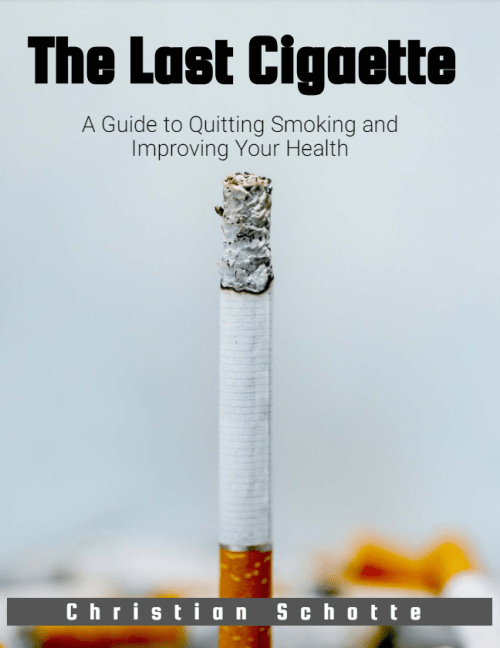The Last Cigarette – A Guide to Quitting Smoking and Improving Your Health
In the journey of life, there often comes a momentous decision that can profoundly impact our health and well-being. For many individuals, that decision revolves around quitting smoking—the final puff of the last cigarette marking the beginning of a smoke-free life. In this comprehensive guide, we delve into the intricacies of quitting smoking and how it can lead to remarkable improvements in your health and overall quality of life.
The Last Cigarette – A Guide to Quitting Smoking…
Digital – Ebook

Understanding the Addiction:
Nicotine, the addictive substance found in tobacco, hijacks the brain’s reward system, creating a cycle of dependence that can be incredibly challenging to break. The first step in quitting smoking is acknowledging the power of this addiction and understanding how it influences your behavior.
Breaking the Habit Loop:
Smoking is not just a physical addiction; it’s also deeply ingrained in our daily routines and habits. From lighting up with morning coffee to taking smoke breaks throughout the day, cigarettes become intertwined with various activities. Breaking this habit loop requires conscious effort and the adoption of new, healthier behaviors to replace smoking rituals.
The Importance of Motivation:
Quitting smoking is a journey that requires a strong sense of motivation and commitment. Take the time to reflect on why you want to quit—whether it’s for your health, family, finances, or personal goals. Keeping your reasons for quitting at the forefront of your mind can provide the motivation needed to overcome cravings and setbacks along the way.
Building Your Quit Smoking Toolbox:
There is no one-size-fits-all approach to quitting smoking, but having a toolbox of strategies and techniques can significantly increase your chances of success. Consider incorporating nicotine replacement therapies, such as patches or gum, to help alleviate withdrawal symptoms. Explore medications like varenicline or bupropion, which can reduce cravings and make quitting more manageable. Additionally, behavioral therapies, counseling, and support groups offer valuable resources for addressing the psychological aspects of addiction.
Setting SMART Goals:
Setting specific, measurable, achievable, relevant, and time-bound (SMART) goals can provide a roadmap for your quitting journey. Whether it’s setting a quit date, gradually reducing your smoking frequency, or tracking your progress with a quit smoking app, SMART goals help you stay focused and accountable.
Managing Withdrawal Symptoms:
Nicotine withdrawal symptoms can vary from mild discomfort to intense cravings and mood swings. Understanding these symptoms and how to manage them is essential for navigating the quitting process. Stay hydrated, practice deep breathing exercises, and engage in physical activity to alleviate withdrawal discomfort. Remember that these symptoms are temporary and will subside as your body adjusts to life without nicotine.
Creating a Support System:
Quitting smoking is not a solitary endeavor—it’s essential to enlist the support of friends, family, and healthcare professionals. Share your quitting goals with loved ones who can provide encouragement, accountability, and understanding during challenging times. Consider joining a support group or seeking counseling to connect with others who are on a similar journey to quit smoking.
Coping with Triggers and Cravings:
Identifying triggers that prompt the urge to smoke and developing strategies for coping with cravings are critical aspects of quitting smoking. Whether it’s stress, social situations, or certain activities, recognizing your triggers empowers you to navigate them more effectively. Find alternative ways to cope with stress, such as exercise, meditation, or hobbies, and have healthy snacks on hand to satisfy oral cravings.
Celebrating Milestones and Rewards:
Quitting smoking is a significant achievement worthy of celebration. Set milestones along your quitting journey, such as one day, one week, or one month smoke-free, and reward yourself for reaching each milestone. Treat yourself to a spa day, a movie night, or a weekend getaway as a way to acknowledge your progress and reinforce your commitment to a smoke-free life.
Staying Smoke-Free for the Long Haul:
Maintaining your smoke-free status requires ongoing effort and vigilance. Avoid situations or environments where smoking is prevalent, and surround yourself with supportive individuals who respect your decision to quit. Practice self-care, prioritize your health, and remind yourself of the benefits of living smoke-free each day.
The Last Cigarette – A Guide to Quitting Smoking…
Digital – Ebook

Conclusion:
Quitting smoking is a transformative journey that holds the promise of improved health, increased vitality, and a renewed sense of freedom. By arming yourself with knowledge, motivation, and a robust set of tools and strategies, you can overcome the challenges of nicotine addiction and embark on a path to better health and well-being. The last cigarette marks not an end, but a new beginning—a chance to reclaim control of your life and embrace a brighter, smoke-free future.

